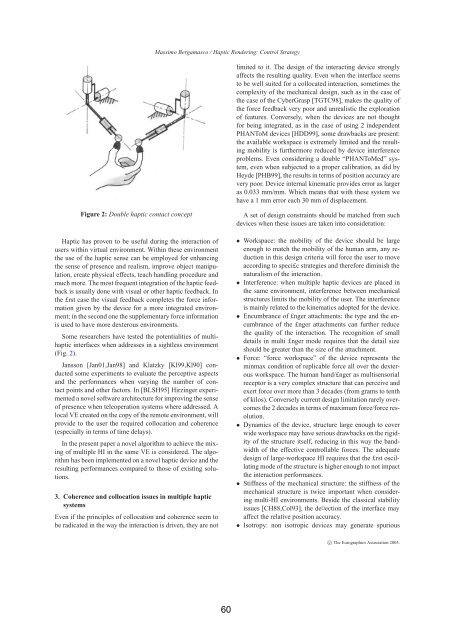full Paper - Nguyen Dang Binh
full Paper - Nguyen Dang Binh
full Paper - Nguyen Dang Binh
Create successful ePaper yourself
Turn your PDF publications into a flip-book with our unique Google optimized e-Paper software.
Figure 2: Double haptic contact concept<br />
Haptic has proven to be useful during the interaction of<br />
users within virtual environment. Within these environment<br />
the use of the haptic sense can be employed for enhancing<br />
the sense of presence and realism, improve object manipulation,<br />
create physical effects, teach handling procedure and<br />
much more. The most frequent integration of the haptic feedback<br />
is usually done with visual or other haptic feedback. In<br />
the £rst case the visual feedback completes the force information<br />
given by the device for a more integrated environment;<br />
in the second one the supplementary force information<br />
is used to have more dexterous environments.<br />
Some researchers have tested the potentialities of multihaptic<br />
interfaces when addresses in a sightless environment<br />
(Fig. 2).<br />
Jansson [Jan01,Jan98] and Klatzky [Kl99,Kl90] conducted<br />
some experiments to evaluate the perceptive aspects<br />
and the performances when varying the number of contact<br />
points and other factors. In [BLSH95] Hirzinger experimented<br />
a novel software architecture for improving the sense<br />
of presence when teleoperation systems where addressed. A<br />
local VE created on the copy of the remote environment, will<br />
provide to the user the required collocation and coherence<br />
(especially in terms of time delays).<br />
In the present paper a novel algorithm to achieve the mixing<br />
of multiple HI in the same VE is considered. The algorithm<br />
has been implemented on a novel haptic device and the<br />
resulting performances compared to those of existing solutions.<br />
3. Coherence and collocation issues in multiple haptic<br />
systems<br />
Even if the principles of collocation and coherence seem to<br />
be radicated in the way the interaction is driven, they are not<br />
Massimo Bergamasco / Haptic Rendering: Control Strategy<br />
60<br />
limited to it. The design of the interacting device strongly<br />
affects the resulting quality. Even when the interface seems<br />
to be well suited for a collocated interaction, sometimes the<br />
complexity of the mechanical design, such as in the case of<br />
the case of the CyberGrasp [TGTC98], makes the quality of<br />
the force feedback very poor and unrealistic the exploration<br />
of features. Conversely, when the devices are not thought<br />
for being integrated, as in the case of using 2 independent<br />
PHANToM devices [HDD99], some drawbacks are present:<br />
the available workspace is extremely limited and the resulting<br />
mobility is furthermore reduced by device interference<br />
problems. Even considering a double “PHANToMed” system,<br />
even when subjected to a proper calibration, as did by<br />
Heyde [PHB99], the results in terms of position accuracy are<br />
very poor. Device internal kinematic provides error as larger<br />
as 0.033 mm/mm. Which means that with these system we<br />
have a 1 mm error each 30 mm of displacement.<br />
A set of design constraints should be matched from such<br />
devices when these issues are taken into consideration:<br />
Workspace: the mobility of the device should be large<br />
enough to match the mobility of the human arm, any reduction<br />
in this design criteria will force the user to move<br />
according to speci£c strategies and therefore diminish the<br />
naturalism of the interaction.<br />
Interference: when multiple haptic devices are placed in<br />
the same environment, interference between mechanical<br />
structures limits the mobility of the user. The interference<br />
is mainly related to the kinematics adopted for the device.<br />
Encumbrance of £nger attachments: the type and the encumbrance<br />
of the £nger attachments can further reduce<br />
the quality of the interaction. The recognition of small<br />
details in multi £nger mode requires that the detail size<br />
should be greater than the size of the attachment.<br />
Force: “force workspace” of the device represents the<br />
minmax condition of replicable force all over the dexterous<br />
workspace. The human hand/£nger as multisensorial<br />
receptor is a very complex structure that can perceive and<br />
exert force over more than 3 decades (from grams to tenth<br />
of kilos). Conversely current design limitation rarely overcomes<br />
the 2 decades in terms of maximum force/force resolution.<br />
Dynamics of the device, structure large enough to cover<br />
wide workspace may have serious drawbacks on the rigidity<br />
of the structure itself, reducing in this way the bandwidth<br />
of the effective controllable forces. The adequate<br />
design of large-workspace HI requires that the £rst oscillating<br />
mode of the structure is higher enough to not impact<br />
the interaction performances.<br />
Stiffness of the mechanical structure: the stiffness of the<br />
mechanical structure is twice important when considering<br />
multi-HI environments. Beside the classical stability<br />
issues [CH88,Col93], the de¤ection of the interface may<br />
affect the relative position accuracy.<br />
Isotropy: non isotropic devices may generate spurious<br />
c○ The Eurographics Association 2005.
















